Click on images to enlarge
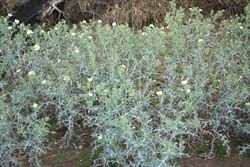
infestation in a dry creek-bed (Photo: Sheldon Navie)

infestation of young plants on a washed-out creekbank (Photo: Sheldon Navie)
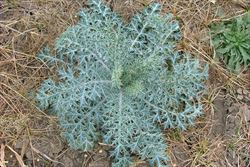
habit prior to flowering (Photo: Sheldon Navie)
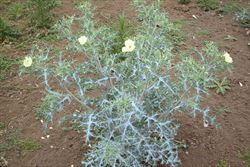
habit of mature plant (Photo: Sheldon Navie)

close-up of variegated leaf showing prickles and the tips of its toothed lobes (Photo: Sheldon Navie)

pale yellow flowers, upper leaves and immature fruit (Photo: Sheldon Navie)

close-up of pale yellow flower with deeply-lobed stigma (Photo: Sheldon Navie)
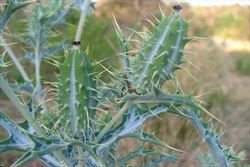
immature fruit (Photo: Sheldon Navie)

mature fruit releasing its numerous seeds (Photo: Sheldon Navie)
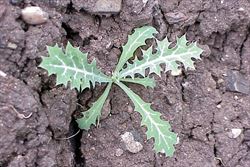
seedling (Photo: Sheldon Navie)
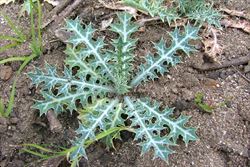
young plant forming a rosette (Photo: Sheldon Navie)
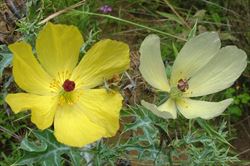
comparison of the bright yellow flowers of Argemone mexicana, left, and cream or very pale yellow flowers of Argemone ochroleuca subsp. ochroleuca, right. Also note that Argemone ochroleuca subsp. ochroleuca has a more deeply lobed stigma (Photo: Sheldon Navie)
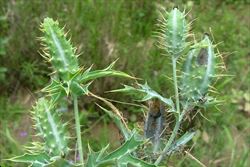
comparison of the leaves and immature fruit of Argemone mexicana, left, and Argemone ochroleuca subsp. ochroleuca, right. Note that the leaves and fruit of Argemone ochroleuca subsp. ochroleuca are more bluish-green in colour (Photo: Sheldon Navie)
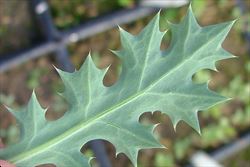
close-up of leaf underside (Photo: Sheldon Navie)
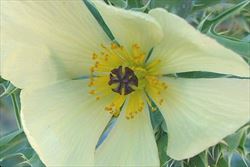
close-up of flower showing deeply-lobed stigma (Photo: Sheldon Navie)
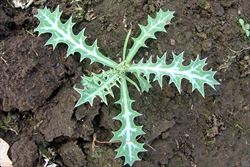
seedling (Photo: Sheldon Navie)
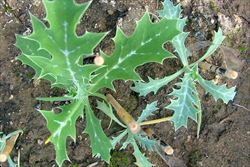
comparison of the seedlings of Argemone mexicana, with green leaves on the left, and Argemone ochroleuca subsp. ochroleuca, with bluish-green leaves on the right (Photo: Sheldon Navie)
Scientific Name
Argemone ochroleuca Sweet subsp. ochroleuca
Synonyms
Argemone mexicana L. (misapplied)Argemone mexicana var. ochroleuca (Sweet) Lindl.Argemone ochroleuca SweetArgemone subfusiformis Ownbey subsp. subfusiformis Ownbey (misapplied)
Family
Papaveraceae
Common Names
devil's fig, Mexican poppy, Mexican pricklepoppy, Mexican thistle, pale Mexican poppy, prickly poppy, white thistle, white-flower Mexican poopy, yellow poppy
Origin
Native to Mexico.
Naturalised Distribution
Mexican poppy (Argemone ochroleuca subsp. ochroleuca ) is naturalised throughout large parts of Australia and is common in the northern and eastern parts of the country. It is particularly widespread throughout Queensland and New South Wales, and is also relatively common in many parts of South Australia, Western Australia and the Northern Territory. It is also naturalised to a lesser extent in the ACT, Victoria and Tasmania.
Also naturalised in many other parts of the world (e.g. Africa, tropical Asia, New Zealand, the Mascarenes and Hawaii).
Note: This species is very similar to Argemone mexicana, which is also known as Mexican poppy, and hence distribution information for these species has often been in error or combined. However, the distribution of Argemone ochroleuca subsp. ochroleuca is much more widespread than that of Argemone mexicana, and it is more apparent in the coastal and sub-coastal regions of eastern Australia.
Habitat
This sepcies is found in a wide range of environments (i.e. from temperate to tropical and from arid to humid), however it is most common in semi-arid, sub-tropical and warmer temperate regions. It is a weed of roadsides, railway lines, sandy stream beds, river flats, waste areas, disturbed sites, gardens, pastures, crops and fallows.
Habit
A short-lived (i.e. annual) herbaceous plant initially forming a basal rosette of leaves, then later developing upright (i.e. erect) stems up to 1.2 m tall.
Distinguishing Features
- a short-lived herb developing a basal rosette of leaves and later growing upright leafy stems.
- its stems and leaves are very prickly and exude a yellowish sap when damaged.
- its leaves are conspicuously bluish or greyish in colour, with whitish veins, and have a variegated appearance.
- these leaves have highly-divided or toothed margins tipped with small spines.
- its flowers are relatively showy (3-7 cm across) with six pale yellow or cream-coloured petals.
- its spiny capsules are oval to oblong in shape (25-45 mm long and 12-18 mm wide).
Stems and Leaves
The prickly stems are conspicuously bluish-green or greyish-green in colour (i.e. glaucous) and much-branched in nature. Stems and leaves are also hairless (i.e. glabrous) and exude a yellowish sap when broken or damaged.
The leaves are initially arranged in a basal rosette and then are alternately arranged along the upright (i.e. erect) stems that develop as the plant matures. These leaves (7-15 cm long and 2-6 cm wide) are also bluish-green or greyish-green in colour (i.e. glaucous), with whitish-coloured veins that give them a variegated appearance. They are deeply divided (i.e. pinnatifid) or sharply toothed (i.e. serrate) and have several sharp spines on their margins. As the plant ages the leaves of the basal rosette die off.
Flowers and Fruit
The spiny flower buds are oblong in shape (8-18 mm long and 4-11 mm wide) and consist of three sepals, each of which is topped with a horn-like projection (5-12 mm long). When the flowers open they are quite showy (3-7 cm across) with six pale yellow, lemon or cream-coloured petals (about 25 mm long). They also have numerous (20-75) stamens and a purplish stigma with spreading lobes exposing bluish-green coloured surfaces between them. Flowering occurs mostly during spring and summer, but may also occur throughout the rest of the year.
The spiny capsules and are generally oval (i.e. ellipsoid), oblong or egg-shaped (i.e. ovoid) and usually have five compartments (occasionally 3-6). These capsules (20-50 mm long and 10-18 mm wide) turn brown in colour as they mature and split open, from the top downwards, to release the numerous seeds contained within. The seeds (1.5-2 mm long) are rounded (i.e. globular) in shape, black or brown in colour, and have a pitted surface.
Reproduction and Dispersal
This species reproduces via large numbers of seed. These seeds may be spread by water, in mud or in contaminated agricultural produce (e.g. grain, pasture seeds and fodder). The entire plant is also known to break off at the base when it dies off and can be blown long distances, thereby helping to spread any seed still present in the old capsules.
Environmental Impact
Mexican poppy (Argemone ochroleuca subsp. ochroleuca) is regarded as an environmental weed in the Northern Territory, Western Australia, Queensland and New South Wales. It is actively managed by community groups in the Northern Territory and was recently also listed as a priority environmental weed in three Natural Resource Management regions. It tends to grow in dry creeks and riverbeds, along creek edges and riverbanks, on floodplains, and in disturbed natural vegetation. In these situations it competes with and replaces native species, and it is most problematic in the beds of seasonal creeks and rivers.
Mexican poppy (Argemone ochroleuca subsp. ochroleuca) is regarded as one of the most important environmental weeds in the river systems and floodplains in the arid regions of the Northern Territory. It also occurs in some catchments (e.g. the McArthur River, the Calvert River and Settlement Creek) in the gulf region in the north-eastern part of the Northern Territory. In a recent survey of the riparian vegetation in the gulf region in north-western Queensland, Mexican poppy (Argemone ochroleuca subsp. ochroleuca) was one of the three most common environmental weeds present. It is also one of the most common weeds present in Currawinya National Park, in the south-west of Queensland. In western New South Wales small outbreaks are widespread, mostly in disturbed situations along the alluvial flats of ephemeral creek lines. It has also been recorded from similar habitats in conservation areas in this state (e.g. in Kirramingly Nature Reserve in the north west plains region and in Kinchega National Park in south-western New South Wales). In Western Australia it is widely distributed along river systems, on moist flats and in sand dunes in the pastoral regions of the state and is also a weed of mine sites, but has yet to reach its potential distribution in this state.
Other Impacts
Mexican poppy (Argemone ochroleuca subsp. ochroleuca) is also a troublesome weed of crops and pastures. It is regarded as a major weed of crops in Queensland and New South Wales. It is also extremely poisonous to livestock and humans, but accounts of livestock poisoning are rare because it is generally avoided by animals. The main danger to livestock, horses and poultry usually comes from fodder and other stockfeeds that have become contaminated with its leaves or seeds. Its very prickly nature also means it can cause injury to humans and livestock.
Legislation
This species is declared under legislation in the following states and territories:
- Western Australia: P1 - trade, sale or movement into the state prevented, and P2 - to be eradicated where found (throughout the parts of the state where it is not yet widely established). P3 - the weed cannot be eradicated in the short term, but must be kept under control, and P4 - the weed must be contained (throughout the parts of the state where it is common or well-established). See the Western Australian Department of Agriculture and Food Declared Plant List at http://www.agric.wa.gov.au/ for more detailed information about which areas are covered by these declarations.
- Northern Territory: B - growth and spread of this species to be controlled (throughout all of the Territory), and C - not to be introduced into the territory.
Management
For information on the management of this species see the following resources:
- the Western Australian Department of Agriculture and Food Farmnote on this species, which is available online at http://www.agric.wa.gov.au.
- the Northern Territory Department of Natural Resources, Environment and The Arts Agnote on this species, which is available online at http://www.nt.gov.au/weeds.
Similar Species
Mexican poppy (Argemone ochroleuca subsp. ochroleuca) is very similar to another closely related species known as Mexican poppy (Argemone mexicana) and may also be easily confused with American poppy (Argemone subfusiformis subsp. subfusiformis). These species can be distinguished by the following differences:
- Mexican poppy (Argemone ochroleuca subsp. ochroleuca) has cream or pale yellow flowers and oblong flower buds that are topped with horns 5-12 mm long. Its conspicuously bluish-green or greyish-green (i.e. glaucous) leaves are variegated with paler whitish markings and its capsules are oblong, oval (i.e. ellipsoid) or egg-shaped (i.e. ovoid).
- Mexican poppy (Argemone mexicana ) has bright yellow flowers and almost rounded (i.e. sub-spherical) flower buds that are topped with horns 5-10 mm long. Its green or slightly bluish-green leaves are variegated with paler whitish markings and its capsules are oblong, broadly oval (i.e. ellipsoid) or egg-shaped (i.e. ovoid).
- American poppy (Argemone subfusiformis subsp. subfusiformis) has pale yellow flowers and oblong flower buds that are topped with horns 10-14 mm long. Its conspicuously bluish-green or greyish-green (i.e. glaucous) leaves are variegated with paler whitish markings and its capsules are spindle-shaped (i.e. fusiform) to narrowly oval (i.e. ellipsoid) in shape.

